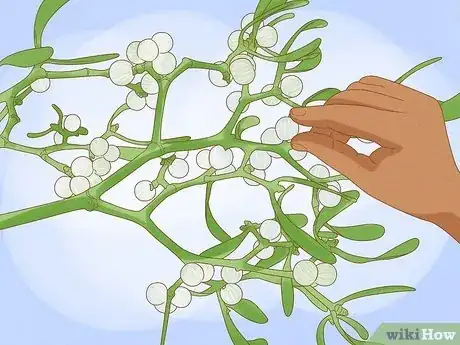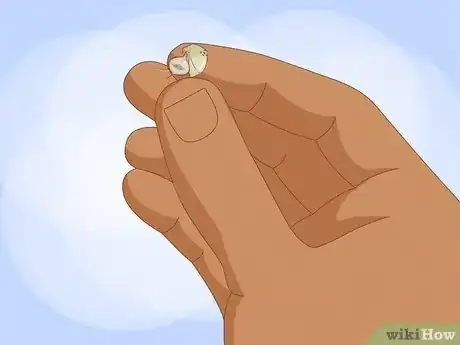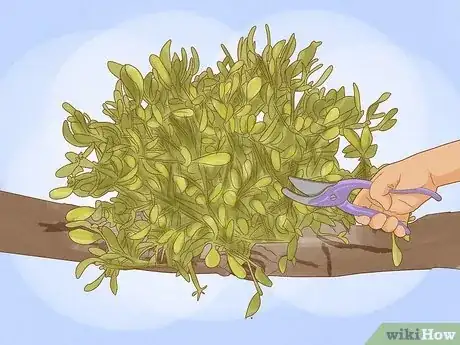This article was co-authored by Lauren Kurtz. Lauren Kurtz is a Naturalist and Horticultural Specialist. Lauren has worked for Aurora, Colorado managing the Water-Wise Garden at Aurora Municipal Center for the Water Conservation Department. She earned a BA in Environmental and Sustainability Studies from Western Michigan University in 2014.
There are 7 references cited in this article, which can be found at the bottom of the page.
This article has been viewed 54,338 times.
Many people have grown up admiring mistletoe decorations each Christmas season and even sharing kisses underneath them. With a bit of work, you can grow mistletoe in your yard to admire and use throughout the year! The growth process is long, lasting around five years until the plant reaches maturation. Knowing how to properly plant and cultivate mistletoe can make the process (and the wait) much easier.
Steps
Harvesting Your Mistletoe
-
1Pick several mistletoe berries from a fully mature branch. The best time of year to gather mistletoe berries is in February, when the berries are fully mature and ready to be planted. You can also purchase them online if there are no mistletoe plants in your area.[1]
- Fresh mistletoe berries are ideal for planting. You can trust they are ripe and ready to germinate, unlike older berries (or berries used in decorations), which may have already begun to decay.[2]
- To identify whether a mistletoe berry is fresh enough to plant, check out the color. Look specifically for white berries; their pale color means they have reached full maturity.[3]
- If you must use older berries, be sure to store them in water until you’re ready to plant. You can submerge your mistletoe in a cup or vase. The mistletoe will also need ample amounts of light; set them near a window to meet this need.[4]
-
2Choose hawthorn, apple, lime, or poplar trees to plant your mistletoe on. These particular species of trees are proven to be the most suitable for mistletoe growth. If you have none of these types of trees nearby, you can try planting your mistletoe on oak tree branches.[5]
- Mistletoe is a partial parasite. Although its leaves do make some energy through photosynthesis, the plant also roots down under the bark of a host tree to take more nutrients from the tree.[6]
- Most trees and shrubs from the Rosaceae family will work.
Advertisement -
3Pinch the mistletoe berries open to extract their seeds. They should come out covered in a viscous material known as “viscin.” Be sure to wipe the seeds partially clean with your fingers before planting them. You should leave only a bit of viscin on the seeds to help them stick to the tree.[7]
Planting Your Mistletoe
-
1Place your mistletoe seeds onto the branches of your tree. All you have to do is stick them on like a decal. The bit of viscin you’ve left on the seed will help it stick to the tree branch so the seed can take root there. Choose smaller, newer branches for planting mistletoe. Picking smaller branches makes it much easier for mistletoe to adhere and start growing. This will also reduce damage to the tree, since mistletoe grows by taking nutrients from the tree.[8]
- Try to stick to branches with a diameter of eight inches. The mistletoe will mature more easily with eight inch branches. This is because they are thin enough for the mistletoe to attach itself to while it grows.[9]
- By sticking the seed to a leaf, you are mimicking a bird releasing a seed in its droppings.
-
2Flag the branches you’ve planted mistletoe on with string or tags. You don’t want to forget where you planted your mistletoe later on. Adding some type of labeling system will help you to remember where your mistletoe has been planted, so you can more easily check on its growth.[10]
-
3Look for signs of germination in the spring. If you planted your mistletoe in February, you should notice your seeds beginning to sprout in March or April of that same year. Newly sprouted mistletoe will look like tiny green stems with no leaves.[11]
-
4Check for noticeable sprouts and leaves by the fourth year of growth. Remember: mistletoe takes a long time to grow. You won’t be able to spot much progress until the fourth year, when the tiny buds of the mistletoe have begun growing higher and developing leaves. From this point onward, you can expect your mistletoe to progress at a much quicker rate.[12]
Caring for Mistletoe
-
1Plant your mistletoe on trees that get lots of sunlight. Mistletoe needs to be exposed to sunlight to survive. Try to choose a tree in your yard that directly faces the sun to help the mistletoe grow.
-
2Don’t worry about watering the mistletoe. It will naturally get all the water it needs from the tree you’ve planted it on. Instead, check the health of your tree from time to time as the mistletoe grows. If you notice the tree becoming weaker, you can give it extra water and fertilizer to boost its health. Caring for the tree will help the mistletoe to thrive, too.[13]
- You can identify a sick tree by its branches. Sick tress may have branches with dead leaves that will not fall off, or branches with no leaves (when it isn’t fall or winter).[14]
- Check out the tree’s trunk to determine its health. Trees will shed their bark from time to time, but a healthy tree will regrow its bark. A sick tree will not replace its bark, so you’ll always see bare wood.[15]
-
3Trim your mistletoe with gardening shears if it starts getting too unruly. You may notice the tree branch the mistletoe is planted on beginning to sag from its weight. Alternatively, you might see other parts of the tree beginning to die. These are two major signs the mistletoe is in need of a trim. Cut away at the outer parts of the mistletoe bush until it’s smaller and even on all sides.[16]
- Keep an eye on the tree after trimming to see whether it starts to regain its health. It may begin growing new leaves, or the branch the mistletoe is on may perk up. If the tree continues to get worse, remove the entire branch. You can try planting new mistletoe on a different tree next year.
Expert Q&A
-
QuestionAre mistletoe berries poisonous to animals and birds?
 Lauren KurtzLauren Kurtz is a Naturalist and Horticultural Specialist. Lauren has worked for Aurora, Colorado managing the Water-Wise Garden at Aurora Municipal Center for the Water Conservation Department. She earned a BA in Environmental and Sustainability Studies from Western Michigan University in 2014.
Lauren KurtzLauren Kurtz is a Naturalist and Horticultural Specialist. Lauren has worked for Aurora, Colorado managing the Water-Wise Garden at Aurora Municipal Center for the Water Conservation Department. She earned a BA in Environmental and Sustainability Studies from Western Michigan University in 2014.
Professional Gardener Mistletoe berries are not poisonous to birds. They are mildly toxic to pets and humans.
Mistletoe berries are not poisonous to birds. They are mildly toxic to pets and humans. -
QuestionWhere can I order seeds to start my own mistletoe?
 Community AnswerYou can order mistletoe seeds from the "English Mistletoe Shop," which can be found online. Try looking around on eBay as well.
Community AnswerYou can order mistletoe seeds from the "English Mistletoe Shop," which can be found online. Try looking around on eBay as well. -
QuestionCan I grow it from a cutting?
 NinoxTop AnswererNo, mistletoe can only grow from seeds. It is impossible to grow it from a cutting.
NinoxTop AnswererNo, mistletoe can only grow from seeds. It is impossible to grow it from a cutting.
Warnings
- Ask the owner of the mistletoe bush you’re collecting from whether it’s okay to gather berries before you pick anything.[20]⧼thumbs_response⧽
- Avoid planting the mistletoe berries from your Christmas decorations. These berries are too old and are unlikely to be able to grow.[21]⧼thumbs_response⧽
- If you managed to obtain mistletoe berries or seeds during the holidays, stow them for only a few months at the longest. They will be ready to plant by February or March. If you don’t plan to plant your mistletoe seeds right away, it’s fine to store them—as long as you put them somewhere well-lit. Mistletoe cannot survive without light. [22]⧼thumbs_response⧽
- Never try to plant mistletoe on the trunk of the tree. This area is much too large for the mistletoe to adhere to and germinate properly.[23]⧼thumbs_response⧽
- While you may be advised to create nicks in tree branches so the mistletoe can stick, this step is unnecessary. In fact, doing this may cause more harm than good. The exposed flesh may make the tree branch more susceptible to decay and sickness. [24]⧼thumbs_response⧽
Things You'll Need
- Mistletoe berries
- A hawthorn, apple, lime, or poplar tree
- Ladder or stepping stool
- Twine, string, or plant tags
References
- ↑ http://mistletoe.org.uk/homewp/index.php/grow-your-own/
- ↑ http://www.telegraph.co.uk/gardening/howtogrow/3345933/Mistletoe-How-to-grow.html
- ↑ http://www.countrylife.co.uk/gardens/gardening-tips/how-to-grow-mistletoe-15713
- ↑ http://www.telegraph.co.uk/gardening/howtogrow/3345933/Mistletoe-How-to-grow.html
- ↑ http://mistletoe.org.uk/homewp/index.php/grow-your-own/
- ↑ http://www.telegraph.co.uk/gardening/howtogrow/3345933/Mistletoe-How-to-grow.html
- ↑ http://mistletoe.org.uk/homewp/index.php/grow-your-own/
- ↑ http://mistletoe.org.uk/homewp/index.php/grow-your-own/
- ↑ http://www.telegraph.co.uk/gardening/howtogrow/3345933/Mistletoe-How-to-grow.html
- ↑ http://mistletoe.org.uk/homewp/index.php/grow-your-own/
- ↑ http://mistletoe.org.uk/homewp/index.php/grow-your-own/
- ↑ http://mistletoe.org.uk/homewp/index.php/grow-your-own/
- ↑ https://centraltexastreecare.com/what-is-mistletoe-and-should-i-be-concerned-if-i-have-it-in-my-trees/
- ↑ https://www.highgrove.net/blog/how-to-tell-if-a-tree-is-dying-on-your-property
- ↑ https://www.highgrove.net/blog/how-to-tell-if-a-tree-is-dying-on-your-property
- ↑ https://www.lovethegarden.com/plant-finder/perennials/mistletoe
- ↑ http://mistletoe.org.uk/homewp/index.php/grow-your-own/
- ↑ http://mistletoe.org.uk/homewp/index.php/grow-your-own/
- ↑ https://www.gardenorganic.org.uk/faqs/growing-mistletoe
- ↑ https://www.gardenorganic.org.uk/faqs/growing-mistletoe
- ↑ http://www.telegraph.co.uk/gardening/howtogrow/3345933/Mistletoe-How-to-grow.html
- ↑ http://mistletoe.org.uk/homewp/index.php/grow-your-own/
- ↑ http://www.countrylife.co.uk/gardens/gardening-tips/how-to-grow-mistletoe-15713
- ↑ http://www.telegraph.co.uk/gardening/howtogrow/3345933/Mistletoe-How-to-grow.html
About This Article
To grow mistletoe, start by pressing the seeds onto tree branches in early spring so they can take root. Choose branches that get a lot of direct sunlight and don't worry about watering the seeds. Germinated seeds, which look like tiny green stems with no leaves, should appear 1-2 months later. After that, you probably won’t see any additional growth until the fourth year, when the tiny buds start developing leaves. At this point, you can expect your mistletoe to start growing much faster! For tips on pruning unruly mistletoe, read on!


































































